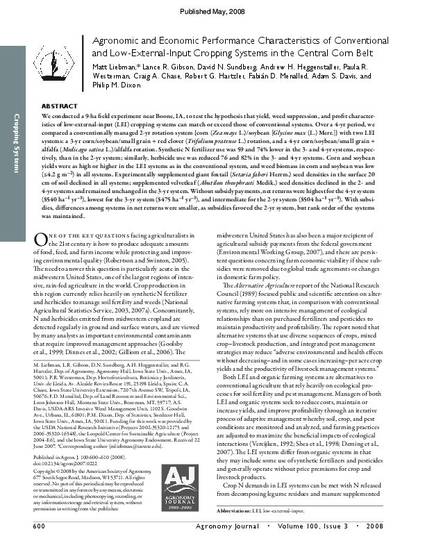
Article
Agronomic and Economic Performance Characteristics of Conventional and Low-External-Input Cropping Systems in the Central Corn Belt
Agronomy Journal
Document Type
Article
Disciplines
Publication Version
Published Version
Publication Date
1-1-2008
DOI
10.2134/agronj2007.0222
Abstract
We conducted a 9-ha field experiment near Boone, IA, to test the hypothesis that yield, weed suppression, and profit characteristics of low-external-input (LEI) cropping systems can match or exceed those of conventional systems. Over a 4-yr period, we compared a conventionally managed 2-yr rotation system {corn (Zea mays L.)/soybean [Glycine max (L.) Merr.]} with two LEI systems: a 3-yr corn/soybean/small grain + red clover (Trifolium pratense L.) rotation, and a 4-yr corn/soybean/small grain + alfalfa (Medicago sativa L.)/alfalfa rotation. Synthetic N fertilizer use was 59 and 74% lower in the 3- and 4-yr systems, respectively, than in the 2-yr system; similarly, herbicide use was reduced 76 and 82% in the 3- and 4-yr systems. Corn and soybean yields were as high or higher in the LEI systems as in the conventional system, and weed biomass in corn and soybean was low (≤4.2 g m−2) in all systems. Experimentally supplemented giant foxtail (Setaria faberi Herrm.) seed densities in the surface 20 cm of soil declined in all systems; supplemented velvetleaf (Abutilon theophrasti Medik.) seed densities declined in the 2- and 4-yr systems and remained unchanged in the 3-yr system. Without subsidy payments, net returns were highest for the 4-yr system ($540 ha−1 yr−1), lowest for the 3-yr system ($475 ha−1 yr−1), and intermediate for the 2-yr system ($504 ha−1 yr−1). With subsidies, differences among systems in net returns were smaller, as subsidies favored the 2-yr system, but rank order of the systems was maintained.
Rights
Works produced by employees of the U.S. Government as part of their official duties are not copyrighted within the U.S. The content of this document is not copyrighted.
Language
en
File Format
application/pdf
Citation Information
Matthew Z. Liebman, Lance R. Gibson, David N. Sundberg, Andrew Howard Heggenstaller, et al.. "Agronomic and Economic Performance Characteristics of Conventional and Low-External-Input Cropping Systems in the Central Corn Belt" Agronomy Journal Vol. 100 Iss. 3 (2008) p. 600 - 610 Available at: http://works.bepress.com/philip-dixon/2/

This is an article from Agronomy Journal 100 (2008): 600, doi:10.2134/agronj2007.0222. Posted with permission.